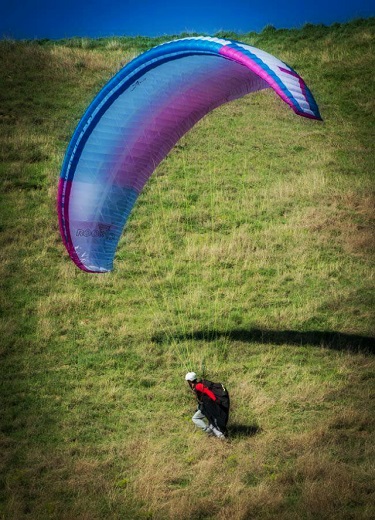“Man must rise above the Earth—to the top of the atmosphere and beyond—for only thus will he fully understand the world in which he lives” – Socrates
The Merriam-Webster dictionary defines Acrophobia as the “abnormal dread of being in a high place”, one out of ten people in the country suffers from it (according to Statistic Brain). A few years ago, I was one of those people, and I still am to some degree. It may sound strange coming from some who’s got issues with heights, but trust me – launching yourself off a cliff with a paraglider strapped to your back is one of the most amazing experiences you can have in your life. So here’s my new post for you Head in the Clouds – An Introduction to Paragliding.

The Basics of Paragliding
Let’s start with a short history lesson. Paragliding first emerged in the 1960s, through a series of parachute upgrades for military purposes. David Barish (1911–2009), who developed a spacecraft recovery device called the “Sail Wing” for NASA, is considered by many to be the “father of paragliding”. When I speak about paragliding, people often tend to confuse it with parasailing. Well, parasailing is not a free-flying sport (you’re being towed by a boat after all) and it doesn’t require much, if any training at all. Paragliding on the other hand, requires you to learn how to find thermal columns of rising air, use them to launch yourself off the ground and rise through the air.
Try 10 MYTHS ABOUT COSMETIC SURGERY
Are There Any Safety Issues?
Before I tried it, I seriously thought that gliding was reserved only for the fearless adrenaline junkies. I was concerned enough about my safety to do some research… and by research, I of course mean Googling. 0.31 seconds and about 253,000 results later I found out that there were only 11 fatal crashes in North America that year (US Hand Gliding and Paragliding 2015 report). In contrast, more people were struck and killed by lightning that year (27 casualties last year, according to the National Weather Service report). So if you have any fears of paragliding (or like in my case, heights) – don’t worry, you’ll probably make it.

What is the Training Like?
Most instructors will tell you right from the get go that most injuries happen because of the mistakes made by the pilot. So before you even take off a few feet of the ground, you need to learn kiting. Ground handling (or kiting) is basically learning how to control your glider and keep it fully loaded with your weight. Most beginners spend a week on the training hill, learning how to maneuver the glider from the ground, but it took me 10 full days to grasp it. Maybe it’s because I have never owned a kite as a kid. After that, I was ready for my first flight. Even though you can fly by yourself right after the initial training, I chose to fly alongside a trainer for the first couple of times.

How Long Do You Stay Up?
Depending on the conditions, most flights last from 15 to 25 minutes, but as my instructor told me, 5-hour flights aren’t uncommon at all. If you get great at it, after a couple of years, you can even fly across the country. As a matter of fact, just last year, three pilots (Frank Brown, Donizete Lemos and Marcelo Prieto) set a new world record by spending 11 hours in the air and flying 513 kilometers (around 320 miles) across the Brazilian northeast.

But How Much Does it Cost?
For the most part, instructors don’t make a living only by giving lessons, so supporting your school with the equipment purchase is important. For starters, most schools offer the beginner training (the P2 course) for around $1500. Additionally, you will have to pay $4000 for the glider and around $1000 for the harness and the reserve parachute. While paragliding is not exactly low-cost, it’s still the cheapest form of aviation available. For example, a private pilot license can cost you up to $12,000, not including additional costs (according to Aviation Schools Online).
Try 9 INTERESTING FACTS ABOUT SEX
The Surprising Health Benefits
– Stress Relief: Adrenaline produces a chemical called neuropeptide Y that works as a natural tranquilizer and regulates your blood pressure. When you’re up in the air, you focus on paragliding and nothing else. The feeling of serenity combined with the adrenaline rush helps you forget about your problems and brings you to a Zen-like state.
– Vitamin D: Spending time on a mountain (or in any natural setting for that matter) will reset your body’s internal clock and enhance the quality of your sleep. Additionally, spending more time in nature will increase your exposure to the sun and increase your Vitamin D intake, strengthening your immune system and preventing hormonal problems.
– Muscle Building and Skin Damages: As you age and your upper body strength slowly deteriorates, your body becomes more prone to injuries. Luckily, just by controlling the wing, you can build your upper arm strength in just a few months. Because of sun and wind exposure, pilots around the globe can experience some skin damages that can easily be fixed with skin tightening procedure.
Nailing the Landing
The Merriam-Webster dictionary defines Aerophobia as the “fear or strong dislike of flying”, about one in five people in the country suffers from it (according to Express) – and I’m not one of those people. While looking down from a balcony still makes me a little nervous, I cannot imagine my life without gliding. Although, sometimes I have to wait weeks for conditions to align with my schedule between flights, it’s always worth the wait.
Also Try
HOW TO IMPROVE SLEEP AND BOOST ENERGY LEVELS




